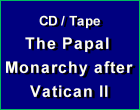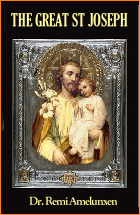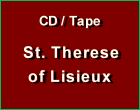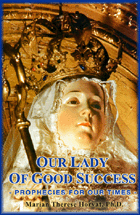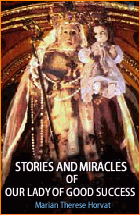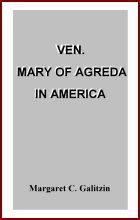Special Devotions
 |
 |
 |
 |
 |
 |
 |
Our Lady Help of Christians:
A Second Victory with Napoleon
On May 24 the Catholic world honors the Mother of God as Our Lady Help of Christians. The first recorded use of this Marian invocation was made by St. John Chrysostom in 345 to express her role as Mediatrix between man and God. One of the oldest prayers directed to Mary is the
Sub tuum praesidium [Under thy protection], which asks Our Lady to help Christians who ask her to deliver them from the dangers of evil.
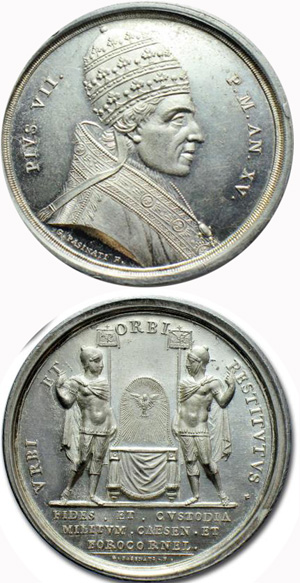 This title took on new splendor as a tribute to the victory she gave to the fleet of the Catholic League over the Muslim forces in the Battle of Lepanto that took place on October 7, 1571. To thank the Queen of Heaven for interceding in this battle waged on the Mediterranean Sea to save Christendom, Pope St. Pius V added the invocation Auxilium Christianorum to the Litany of Our Lady.
This title took on new splendor as a tribute to the victory she gave to the fleet of the Catholic League over the Muslim forces in the Battle of Lepanto that took place on October 7, 1571. To thank the Queen of Heaven for interceding in this battle waged on the Mediterranean Sea to save Christendom, Pope St. Pius V added the invocation Auxilium Christianorum to the Litany of Our Lady.
The 19th century had the happiness to see Pope Pius VII institute a feast to Our Lady Help of Christians on May 24 to acknowledge another great triumph Our Lady gave the Church. On May 24, 1815, Pope Pius VII re-entered Rome amid the acclamations of the people of the Holy City, from which he had been kidnapped during the night by the soldiers of Napoleon Bonaparte five years earlier.
The entire population of Rome went out to meet the Bishop of Rome, holding palm branches and cheering his return. As the triumphal horse-drawn carriage neared the Flaminian Gate, the excitement of the crowd increased. The horses were unyoked and men took the places of the steeds to convey the Pope on the last leg of the way to the Vatican Basilica. There, a solemn thanksgiving was made over the Tomb of the Prince of the Apostles. The Pastor was returned to his flock.
From 1809 to 1815, the Pope was a prisoner of that ambitious tyrant, who had occupied Rome and annexed the Papal States to France in 1809. Exiled first in the Italian city of Savona and then at the Chateau of Fontainebleau near Paris, Pius VII suffered untold humiliations at the hands of Napoleon Bonaparte. It was then that the Pope made a vow to crown an image of Our Lady should she assist him and secure his freedom.
To fulfill his promise, Pius VII instituted an annual feast day of universal scope honoring Our Lady, Help of Christians. He decreed it should be celebrated on May 24, the day of his triumphant re-entry into Rome, as an acknowledgment of her assistance in reinstating the spiritual government of the Catholic world.
A second victory of Our Lady
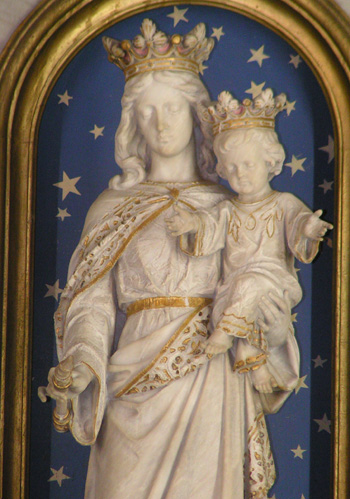 There is an interesting note to the end of this drama. For, in this case, Divine Justice made itself felt on earth for Napoleon's affront to the Supreme Pontiff. Less than five years after his excommunication, Napoleon had to sign his own abdication in the very Chateau of Fontainebleau where he had impiously imprisoned the Sovereign Pontiff.
There is an interesting note to the end of this drama. For, in this case, Divine Justice made itself felt on earth for Napoleon's affront to the Supreme Pontiff. Less than five years after his excommunication, Napoleon had to sign his own abdication in the very Chateau of Fontainebleau where he had impiously imprisoned the Sovereign Pontiff.
The excommunicated tyrant was exiled to the remote island of St. Helena. For five years he had held the Supreme Pontiff captive. For five years he himself had to endure the sufferings and humiliation of captivity.
But Our Lady Help of Christians had a second victory to claim. In 1821, Napoleon's health began to deteriorate rapidly. A messenger from the Island of Saint Helena was one day ushered into the presence of Pius VII, relates Dom Guéranger in his entry on Our Lady Help of Christians. (The Liturgical Year, vol. 8). The deposed Emperor now besought the Pontiff, the true and only King of Rome, to allow him to be re-admitted to those spiritual blessings of which he had been justly deprived.
Pius VII readily complied with the request thus made of him, and sent Abbé Ange Vignali to the Island of Saint Helena. Napoleon reconciled with the Catholic Church.
Summoning the Abbé to him, he gave these instructions: "I was born a Catholic and will fulfill the duties prescribed by the Catholic Religion, and receive the assistance she administers. You will say Mass every day in the chapel and will expose the Holy Sacrament during Forty Hours. After my death, you will place your altar at my head in the room in which I shall lie in state. You will continue to say Mass, and perform all the customary ceremonies, and will not cease to do so until I am under the ground." (The Last Days of the Emperor Napoleon by Fr. Vignali, in The Literary Chronicle and Weekly, issues 294-316, pp. 233-234).
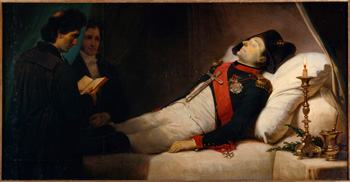 Napoleon Bonaparte died on May 5, 1821. After receiving the Sacraments of Confession and the Viaticum five days earlier, he fell into a coma, and Fr. Vignali was at his side to administer Extreme Unction and give the last absolution as he passed away.
Napoleon Bonaparte died on May 5, 1821. After receiving the Sacraments of Confession and the Viaticum five days earlier, he fell into a coma, and Fr. Vignali was at his side to administer Extreme Unction and give the last absolution as he passed away.
What better proof can there be of Our Lady's help to her children than this conquest of the haughty Emperor who dared to crown himself before the altar in Notre Dame Cathedral? She is a compassionate Mother ever ready with her aid, both in a danger that affects the Church at large, or to a single individual soul, even one who made such defiant and blasphemous affronts to the Holy Church and the Prince of the Apostles.
As Dom Guéranger closes: "God willed her to be so – the Help of Christians – and we are but complying with His wishes when we have an unreserved confidence in the protection of this powerful Queen, this loving Mother."


Medal coined to commemorate Pope Pius VII's return to Rome
The 19th century had the happiness to see Pope Pius VII institute a feast to Our Lady Help of Christians on May 24 to acknowledge another great triumph Our Lady gave the Church. On May 24, 1815, Pope Pius VII re-entered Rome amid the acclamations of the people of the Holy City, from which he had been kidnapped during the night by the soldiers of Napoleon Bonaparte five years earlier.
The entire population of Rome went out to meet the Bishop of Rome, holding palm branches and cheering his return. As the triumphal horse-drawn carriage neared the Flaminian Gate, the excitement of the crowd increased. The horses were unyoked and men took the places of the steeds to convey the Pope on the last leg of the way to the Vatican Basilica. There, a solemn thanksgiving was made over the Tomb of the Prince of the Apostles. The Pastor was returned to his flock.
From 1809 to 1815, the Pope was a prisoner of that ambitious tyrant, who had occupied Rome and annexed the Papal States to France in 1809. Exiled first in the Italian city of Savona and then at the Chateau of Fontainebleau near Paris, Pius VII suffered untold humiliations at the hands of Napoleon Bonaparte. It was then that the Pope made a vow to crown an image of Our Lady should she assist him and secure his freedom.
To fulfill his promise, Pius VII instituted an annual feast day of universal scope honoring Our Lady, Help of Christians. He decreed it should be celebrated on May 24, the day of his triumphant re-entry into Rome, as an acknowledgment of her assistance in reinstating the spiritual government of the Catholic world.
A second victory of Our Lady

Statue of Our Lady Auxilium Christianorum in the Sacred Heart of Jesus Church in São Paulo, Brazil
The excommunicated tyrant was exiled to the remote island of St. Helena. For five years he had held the Supreme Pontiff captive. For five years he himself had to endure the sufferings and humiliation of captivity.
But Our Lady Help of Christians had a second victory to claim. In 1821, Napoleon's health began to deteriorate rapidly. A messenger from the Island of Saint Helena was one day ushered into the presence of Pius VII, relates Dom Guéranger in his entry on Our Lady Help of Christians. (The Liturgical Year, vol. 8). The deposed Emperor now besought the Pontiff, the true and only King of Rome, to allow him to be re-admitted to those spiritual blessings of which he had been justly deprived.
Pius VII readily complied with the request thus made of him, and sent Abbé Ange Vignali to the Island of Saint Helena. Napoleon reconciled with the Catholic Church.
Summoning the Abbé to him, he gave these instructions: "I was born a Catholic and will fulfill the duties prescribed by the Catholic Religion, and receive the assistance she administers. You will say Mass every day in the chapel and will expose the Holy Sacrament during Forty Hours. After my death, you will place your altar at my head in the room in which I shall lie in state. You will continue to say Mass, and perform all the customary ceremonies, and will not cease to do so until I am under the ground." (The Last Days of the Emperor Napoleon by Fr. Vignali, in The Literary Chronicle and Weekly, issues 294-316, pp. 233-234).

Napoleon asked to die with the assistance of the Catholic Church he had violently persecuted
What better proof can there be of Our Lady's help to her children than this conquest of the haughty Emperor who dared to crown himself before the altar in Notre Dame Cathedral? She is a compassionate Mother ever ready with her aid, both in a danger that affects the Church at large, or to a single individual soul, even one who made such defiant and blasphemous affronts to the Holy Church and the Prince of the Apostles.
As Dom Guéranger closes: "God willed her to be so – the Help of Christians – and we are but complying with His wishes when we have an unreserved confidence in the protection of this powerful Queen, this loving Mother."

Posted May 23, 2020




